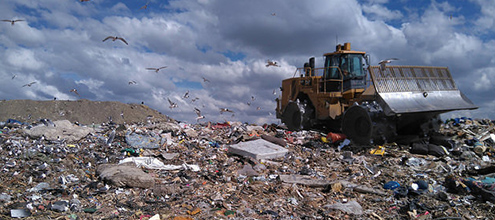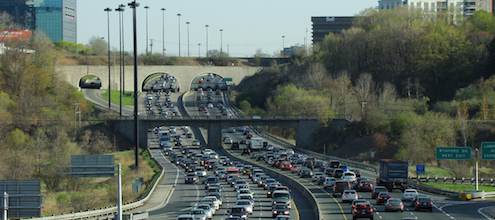
Artificially cheap: Why landfills should charge the full cost of waste disposal
The last blog in our solid waste series explored how charging households directly for their garbage can make municipal collection systems more efficient. But household waste represents only one-third of Canada’s total solid waste. Two-thirds is industrial and commercial waste, most of which is taken directly to local landfills.
This blog looks at the importance of tipping fees, which are charges to “tip” garbage at landfills. When these charges cover the full cost of disposal—including both financial and environmental costs—they create strong incentives to landfill less waste. Diverting more waste can both delay the need to build expensive new landfills and generate important environmental benefits.
The price is right
Tipping fees are a natural starting point to improve how we manage solid waste. Every community either has a landfill within its borders or trucks their waste to a landfill in a neighbouring community. And because so much of our waste is landfilled in Canada (a whopping three-quarters), tipping fees act as a benchmark for the rest of the waste system—changing the economic viability of waste diversion and prevention.
Fees that reflect the full cost of disposal send a more accurate price signal to waste generators: it lets them decide whether it’s better to take their waste to a landfill, or whether to look for alternatives, like recycling and composting. If landfilling costs more than recycling, waste generators will recycle more and landfill less. This helps strike a more optimal—or efficient—balance between different waste management options.
Down in the dumps
Despite a lack of data, evidence suggests that tipping fees are typically lower than the full cost of landfilling. The clearest case is in communities—such as some facilities in Saskatchewan, Manitoba, and Nunavut—that don’t charge tipping fees at all. Landfilling is effectively free. The municipal landfill in the City of Brandon, Manitoba, for example, charges nothing for loads under 500 kg.
But it’s not just the extreme cases that are problematic. Landfills generally fail to charge rates that reflect the full spectrum of costs. Most landfills charge tipping fees that cover basic operating costs; however, few include the full range of capital costs needed to build, maintain, and upgrade infrastructure. Even fewer facilities charge fees that incorporate the “opportunity cost” of landfill space. This cost reflects the fact that landfill capacity is finite and each additional tonne of material hastens the time a community will need to build an expensive new landfill (or ship waste to landfills further away).
Tipping fees also exclude many of the social costs associated with landfilling. Living near waste disposal facilities, for example, can create a number of issues for nearby residents, from potential odour, unsightliness, and social stigma. These “amenity losses” can depress nearby property values. And despite improvements to environmental standards, landfills can still pose contamination risks to local ecosystems. Landfills also represent about 20% of Canada’s total methane emissions—a potent greenhouse gas. Tipping fees never capture these social costs fully.
Artificially cheap waste disposal is a big problem. It helps explain why Canadians generate and landfill so much solid waste. It accelerates how quickly existing landfills reach capacity, requiring new ones to be built earlier. Cheap disposal also undermines incentives to innovate new, low-cost waste diversion opportunities.
So how can communities set market signals straight?
Getting disposal incentives right
For municipalities that own or operate a landfill, the first step is to take better stock of their costs. This process, known as “full-cost accounting,” assesses all existing and future financial costs of waste disposal, including all amortized capital costs and operating costs. It also includes estimating the social costs associated with waste disposal systems. To date, very few municipalities have done this analysis.
Only after communities have thoroughly assessed disposal costs can they charge tipping fees that reflect the full cost. At the very least, full-cost accounting can identify the gap between where rates are and where they need to be.
A second step is ensuring that materials that are more costly to manage carry a higher price. These “differentiated tipping fees” are quickly becoming an industry best practice. Many landfills, for example, now charge higher tipping fees for loads that contain organics, reflecting the higher environmental costs of these materials, like methane emissions, leachate (i.e., toxic landfill juice), and odours for surrounding residents. Other municipalities are also charging higher rates for lightweight and voluminous materials, such as polystyrene (i.e., Styrofoam), which take up valuable landfill space.
Lastly, provincial regulations play a critical role. Environmental regulations require operators (public and private) to better manage their environmental impacts, both during operation and after sites close. This includes, for example, capturing methane emissions, requiring thicker liners, or extending operators’ responsibility for environmental damages. Such regulations allow operators to pass on any additional costs through higher tipping fees.
Dusting off an old tool
Humans have used landfills to bury waste for centuries. But the amount that ends up in landfills today—both in Canada and around the world—is staggering. Garbage today also contains more toxic and hazardous material, which can pose environmental risks for years after they’re buried.
Paying tipping fees that properly reflect these costs makes a lot of sense. It can reduce how much waste we landfill and improve resource recovery. It can save governments and taxpayers money, especially over time, as we need fewer landfills. Finally, it can make for a cleaner environment.
If we want more efficient waste systems, we should stop making it artificially cheap to landfill. Until then, burying our trash in the ground will continue to look like a better option than it really is.
Online course: Municipal market-based tools for sustainable development Sign up now for this new and unique Ecofiscal course, designed for municipal employees.




Comments are closed.